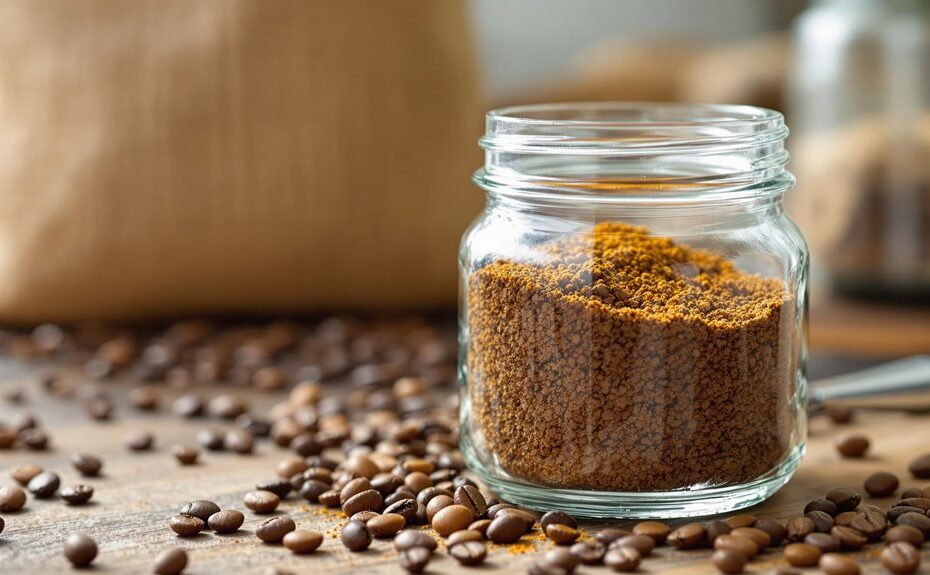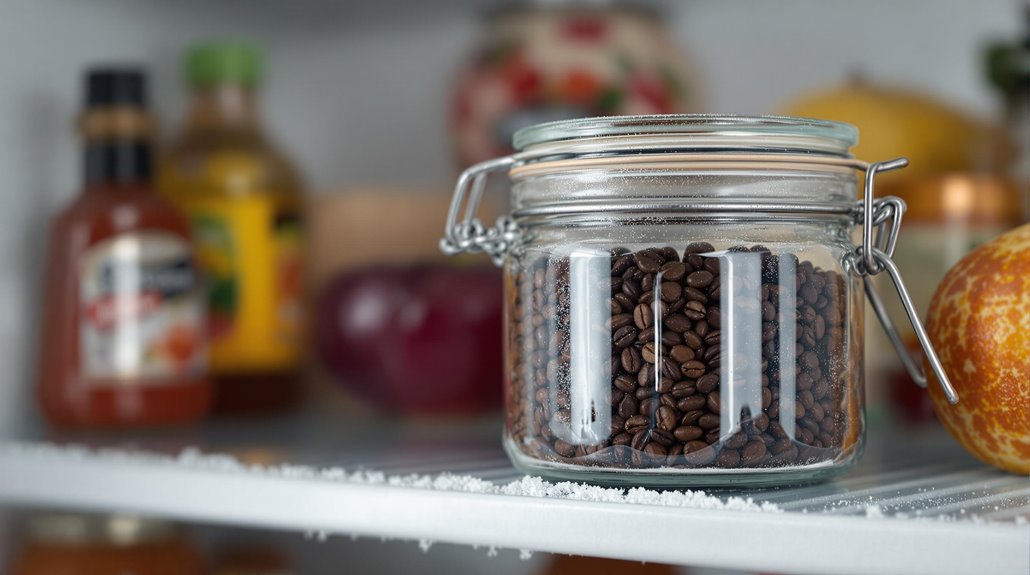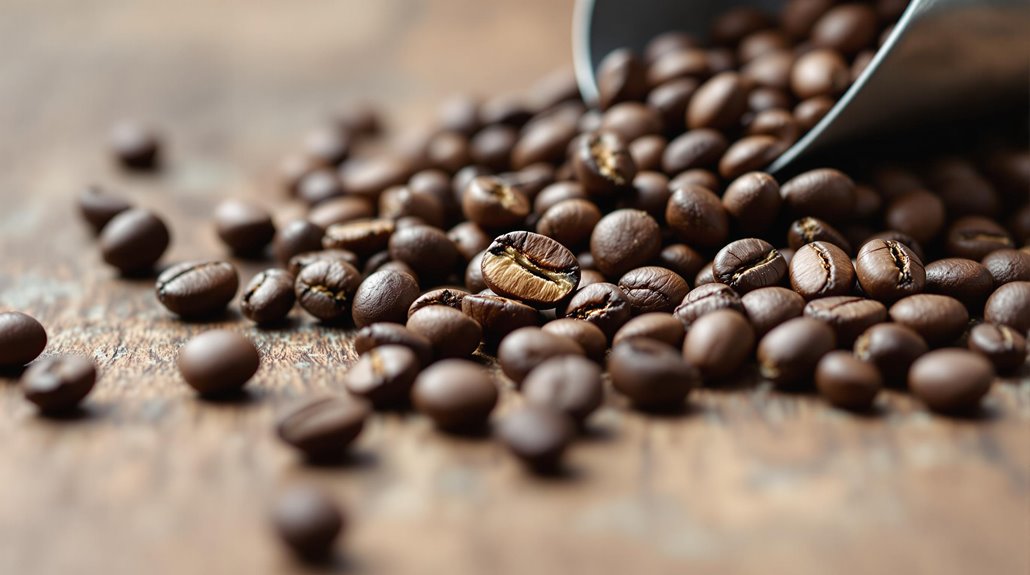







You might think storing ground coffee is as simple as tossing it in a bag or jar, but the truth is, improper storage can ruin its flavor and freshness. Air, light, heat, and moisture are your coffee's worst enemies, and even small mistakes can lead to stale, bland brews. While some swear by freezing or refrigerating, others argue these methods do more harm than good. So, what's the best way to keep your coffee tasting its best? The answer lies in understanding how to balance storage conditions, container choices, and practical habits—but the details might surprise you.
Key Takeaways
- Store ground coffee in airtight, opaque containers to block oxygen, light, and moisture, preserving freshness and flavor.
- Keep ground coffee in a cool, dark place like a pantry, away from heat, humidity, and direct sunlight.
- Avoid refrigeration as it introduces moisture and odors, which degrade coffee quality and aroma.
- Freeze ground coffee in airtight, moisture-proof containers for long-term storage, but thaw at room temperature before use.
- Divide large quantities into small batches and store in separate airtight containers to minimize air exposure and maintain freshness.
Understanding Ground Coffee Freshness
Ground coffee begins to lose its freshness the moment it's exposed to air, light, and moisture. The surface area exposed in ground coffee is far greater than in whole coffee beans, making it more vulnerable to oxidation and staling. When oxygen interacts with the coffee, it degrades the aromatic compounds and oils that give your brew its flavor. Moisture, whether from humidity or direct contact, accelerates this process and can even lead to mold growth. To preserve freshness, you need to minimize exposure to these elements.
Storing ground coffee at room temperature in an airtight container is essential. Avoid clear containers that let in light, as UV rays can further degrade the coffee. While the expiration date on the packaging gives you a rough guideline, the roast date is a more accurate indicator of freshness. Coffee is at its peak within two weeks of roasting, so aim to use it within that window. If you can, buy whole coffee beans and grind them as needed—this reduces the surface area exposed and keeps your coffee fresher for longer. Proper storage guarantees you get the most out of every cup.
Optimal Storage Containers for Ground Coffee
Airtight containers are essential for preserving ground coffee's freshness by blocking oxygen and moisture, which can quickly degrade its flavor and aroma. Opt for opaque materials like ceramic or stainless steel to shield your coffee from light exposure, as clear containers can accelerate flavor loss unless stored in complete darkness. Containers with one-way valves also help by releasing carbon dioxide while keeping oxygen out, ensuring your coffee stays fresher for longer.
Airtight Containers Benefits
To keep your ground coffee fresh and flavorful, it's essential to lock in its quality by using airtight containers. These containers prevent oxygen from seeping in, which slows down the oxidation process that degrades your coffee's flavor and aroma. By minimizing oxygen exposure, you preserve the volatile compounds that give coffee its rich taste and enticing smell. Opt for opaque airtight containers made from materials like stainless steel or ceramic, as they block harmful UV light and don't absorb odors or impart unwanted flavors. Containers with one-way valves are particularly effective, as they allow carbon dioxide to escape while keeping oxygen out, maintaining freshness for up to two weeks. Store your airtight container at room temperature in a cool, dark place to further protect the coffee from heat and light, which can accelerate staling. By investing in the right airtight container, you guarantee your ground coffee retains its peak flavor and aroma for as long as possible.
Material Impact on Freshness
The material of your storage container plays a significant role in maintaining the freshness of ground coffee. Opaque, airtight containers made of ceramic or stainless steel are ideal because they block light and prevent air exposure, which can lead to oxidation and flavor degradation. Glass containers can also work if you store them in a dark place, but make certain they're airtight to avoid compromising the coffee's quality. Avoid plastic containers, as they tend to absorb odors and may impart unwanted flavors to your ground coffee over time. For peak freshness, consider containers with one-way valves, which allow carbon dioxide to escape while keeping oxygen out, extending the shelf life of your coffee. If you choose metal containers, make sure they're lined with a food-safe material to prevent any metallic taste from transferring to the coffee. By selecting the right material—ceramic, stainless steel, or properly stored glass—you'll protect your ground coffee from environmental factors that accelerate flavor loss.
Why Refrigeration Is Not Recommended
Refrigerating ground coffee might seem like a good idea to preserve freshness, but it actually does more harm than good. When you store your coffee in the fridge, it's exposed to moisture and odors, which can ruin its flavor and aroma. Ground coffee is highly porous, meaning it absorbs moisture and odors from its surroundings. This not only compromises the taste but also accelerates the staling process. Even if you keep your coffee in an airtight container, condensation forms when you take it out of the fridge, introducing moisture that can cause the grounds to clump and degrade.
For proper ground coffee storage, you should always keep it away from moisture and strong-smelling foods. Storing coffee beans or grounds in the fridge isn't ideal because the fluctuating temperatures and humidity levels can cause the coffee to lose its freshness faster than if stored properly at room temperature. Instead, focus on keeping your coffee in an airtight container in a cool, dark place. This guarantees the grounds stay dry and retain their flavor, giving you a better cup every time.
Best Locations for Storing Ground Coffee
Finding the best spot to store your ground coffee can make all the difference in preserving its flavor and aroma. To keep it fresh, store ground coffee in a cool, dark place like a pantry or cabinet, away from heat and light, which can degrade its quality. Avoid storing it near moisture-prone areas such as sinks or dishwashers, as humidity can lead to spoilage or mold. Instead, opt for a dry place with stable room temperature (50-70°F), as fluctuations in temperature can compromise freshness. Always keep your ground coffee away from air, heat, and light by transferring it from its original packaging into an opaque, airtight storage container. This shields it from exposure and helps maintain its rich aroma and taste. Avoid storing ground coffee in the refrigerator, as the humidity and temperature changes can harm its quality. By following these guidelines, you'll guarantee your ground coffee stays fresh and flavorful for up to two weeks.
Freezing Ground Coffee: Pros and Cons
Freezing ground coffee can be a practical solution to extend its shelf life, but it's not without trade-offs. When you freeze ground coffee, you slow down oxidation and staling, preserving its freshness for longer. However, improper storage can lead to flavor degradation. Always use an airtight, moisture-proof container to prevent freezer burn and absorption of odors. For the best results, vacuum-sealed packaging is ideal, as it minimizes exposure to air and moisture, extending the coffee's shelf life up to a year. Without vacuum-sealing, aim to use frozen ground coffee within one to two months for peak flavor.
When you're ready to use frozen ground coffee, thaw it at room temperature for about an hour. Avoid refreezing thawed coffee, as repeated freezing and thawing can introduce moisture and compromise flavor. While freezing coffee is effective for long-term storage, it's not a perfect solution. The process can slightly alter the coffee's flavor profile, so weigh the benefits of extended shelf life against potential changes in taste. Properly storing and thawing your ground coffee guarantees you get the most out of this method.
Tips to Extend Ground Coffee Shelf Life
To extend your ground coffee's shelf life, always store it in an opaque, airtight container to block light and prevent air exposure. Keep the container in a cool, dark place like a pantry, as heat and light accelerate flavor degradation. Avoid clear or loosely sealed containers, as they allow light and air to compromise freshness quickly.
Airtight Containers Essential
Using an airtight container is essential for preserving the freshness and flavor of ground coffee. When you store coffee in an airtight container, you prevent exposure to air, which slows down oxidation and preserves the taste and aroma of fresh beans. Opt for containers made of ceramic or glass with tight-fitting lids, as plastic or metal can impart unwanted flavors. Look for containers with one-way valves, which allow carbon dioxide to escape while keeping oxygen out, maintaining freshness for up to two weeks.
To maximize shelf life, divide large quantities of ground coffee into small batches and store them in separate airtight containers. This minimizes repeated exposure to air when you open the container for daily use. Always keep your airtight container in a cool, dark place, like a pantry, to protect the coffee from direct sunlight and temperature fluctuations. Avoid placing it near heat sources or in humid areas, as moisture can degrade quality. By using an airtight container and storing your coffee properly, you'll guarantee every cup retains its rich, full-bodied flavor.
Avoid Light and Heat
Light and heat are the enemies of ground coffee, quickly robbing it of its vibrant flavor and aroma. To keep your ground coffee fresh, store it away from direct sunlight and heat sources like stoves, ovens, or appliances that generate warmth. Exposure to temperatures above 70°F accelerates oxidation, causing your coffee to stale faster. Instead, opt for a cool, dark place, such as a pantry or cupboard, to preserve its quality.
When storing ground coffee, choose an opaque, airtight container made of ceramic or stainless steel. These materials provide better insulation against light and heat compared to glass or plastic. Avoid clear containers, as they allow light to penetrate, degrading the coffee's essential oils and compounds.
Disclosure: As an Amazon Associate, I earn from qualifying purchases.




